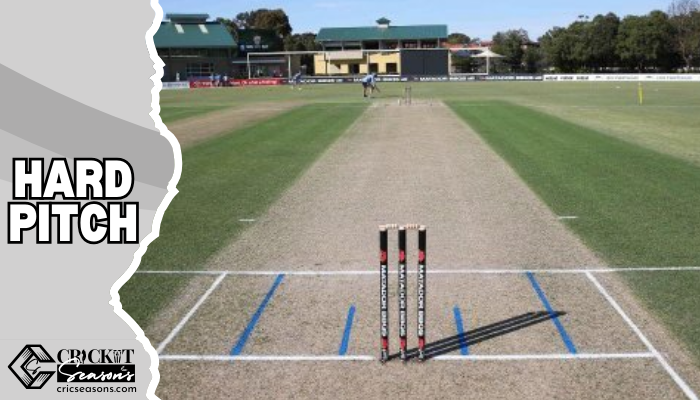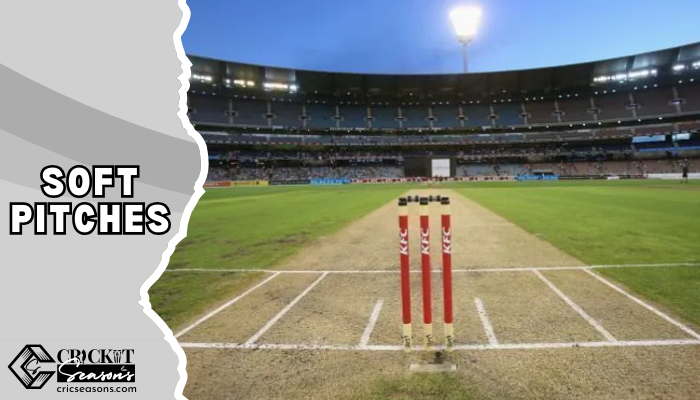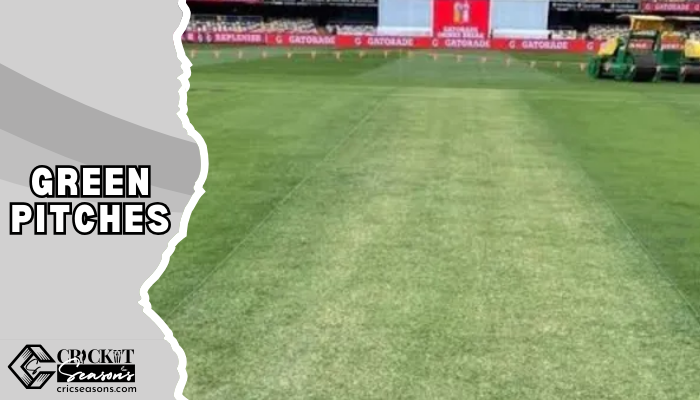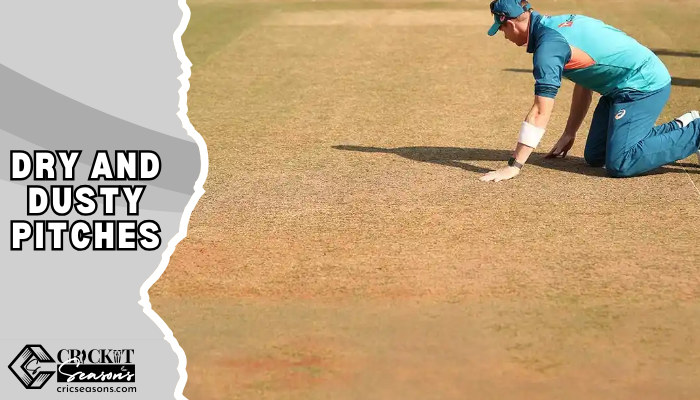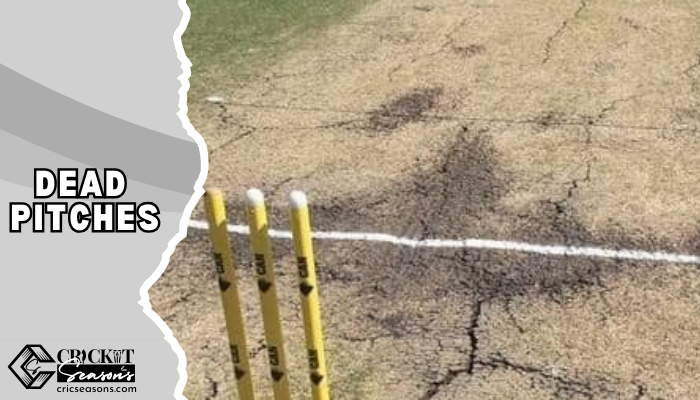In cricket, the pitch plays a pivotal role in determining the course of the game. It’s not just the players’ skills that decide the outcome; the condition of the pitch significantly influences how the ball behaves, and consequently, how the game unfolds.
A cricket pitch, roughly 22 yards in length, can vary in its characteristics depending on factors such as soil type, weather, and maintenance practices. Understanding the different types of pitches in cricket can give you a strategic edge, whether you’re a player, a coach, or an enthusiast. Let’s break down the various types of pitches in cricket you might encounter on the cricket field.
Contents
Types of Pitches in Cricket
Hard Pitches
Hard pitches are known for their firm surface, which makes them ideal for fast bowlers. The ball tends to bounce higher and quicker, creating a challenge for batsmen who must adjust to the extra pace. These pitches are often seen in regions with dry climates where the soil can be compacted tightly.
Fast bowlers thrive on hard pitches because the ball comes onto the bat quickly, forcing batsmen to make split-second decisions. On the other hand, spinners might struggle as there’s less grip for turn, making it easier for batsmen to play through the line.
Soft Pitches
In contrast, soft pitches have a spongier surface due to moisture or a lack of rolling, which slows the ball down after it hits the ground. These conditions favor spin bowlers and seamers who rely on movement rather than pace.
The ball can grip the surface, leading to unpredictable deviations, especially later in the match as the pitch wears down. Batting on a soft pitch requires patience and skill to handle the varying pace and bounce. Batsmen often need to focus on playing late to counter the movement off the pitch.
Green Pitches
Green pitches are characterized by a significant amount of grass on the surface, which can make the pitch appear lush and verdant. These pitches are a paradise for seam bowlers, particularly early in a match when the ball tends to move laterally, both in the air and off the seam. The grass cover helps maintain moisture, which aids in swing and seam movement, making life difficult for batsmen.
They must deal with unpredictable movement and varying bounce. As the match progresses, the green cover usually wears off, making the pitch more favorable for batting. However, early wickets can put immense pressure on the batting side, especially in conditions that enhance swing.
Dry and Dusty Pitches
Dry and dusty pitches are a common sight in subcontinental conditions, particularly in countries like India and Pakistan. These pitches are typically devoid of grass and have a dry, brittle surface that tends to crack as the match progresses. Such conditions are heaven for spin bowlers, as the ball grips the surface and turns sharply, often leading to inconsistent bounce.
Batting on these pitches requires not just skill but also a sound strategy to counter the turn and bounce. Batsmen often rely on footwork, either coming down the pitch to smother the spin or going deep in the crease to play late. Fast bowlers may resort to reverse swing as the rough surface scuffs up the ball.
Dead Pitches
Dead pitches are often flat surfaces that offer very little assistance to both bowlers and batsmen. These pitches are known for their lack of bounce and movement, making them challenging for bowlers to extract any significant pace or spin. Fast bowlers find it difficult to generate bounce, while spinners struggle to get any turn.
As a result, matches on dead pitches can become high-scoring affairs, with batsmen dominating the proceedings. These conditions are often seen towards the end of a Test match or in limited-overs games where the pitch is designed to last for a full 50 overs. Batting on a dead pitch is relatively easier, allowing batsmen to play their shots freely without much concern for unpredictable ball behavior.
Pitch Preparation and Maintenance
Preparation Techniques
The preparation of a cricket pitch is an art that requires a deep understanding of the soil, weather, and the type of game to be played. Groundsmen use a combination of rolling, watering, and mowing to create the desired pitch conditions. For a hard pitch, heavy rolling is essential to compact the soil, creating a firm surface that supports fast bowling.
In contrast, soft pitches require less rolling and more watering to retain moisture, which can make the surface spongy and conducive to spin. The amount of grass left on the pitch is also crucial; leaving more grass creates a green pitch favorable for seamers, while cutting it short can result in a batting-friendly surface. The timing of these activities is equally important, as last-minute changes can drastically alter the pitch’s behavior.
Maintenance During a Match
Maintaining a pitch during a match is a delicate task, as conditions can change due to weather and wear from the players. Groundsmen often water the pitch lightly to prevent it from drying out too quickly, especially in hot conditions. Rolling is usually done between innings to keep the surface level and prevent cracks from widening.
In some cases, they may use sawdust or sand to absorb excess moisture after rain, ensuring the pitch remains playable. The balance between maintaining the pitch’s integrity and allowing natural wear to occur is key to preserving the quality of the game throughout the match.
Impact of Weather on Pitch Conditions
The Role of Rain and Humidity
Weather conditions play a crucial role in how a cricket pitch behaves, with rain and humidity being two of the most influential factors. Rain can soften a pitch, making it slower and offering more assistance to spin bowlers. When a pitch gets wet, the moisture seeps into the surface, causing the ball to skid or stop unexpectedly.
This can lead to variable bounce, making it difficult for batsmen to judge the pace and movement of the ball. Humidity, on the other hand, often helps swing bowlers, as the moisture in the air can cause the ball to swing more in the air before it reaches the pitch. This combination of a softened pitch and increased swing can create challenging conditions for the batting side.
Hot and Dry Conditions
In contrast, hot and dry conditions can significantly alter a pitch, often leading to its deterioration over time. As the pitch dries out, it tends to develop cracks, which can lead to unpredictable bounce and turn. Spin bowlers thrive in these conditions as the ball grips the dry surface and turns sharply. Fast bowlers may also benefit from reverse swing, as the rougher side of the ball can be used to great effect.
The intense heat can also sap the moisture out of the pitch, making it harder and more abrasive. For batsmen, this means a greater challenge, as they have to deal with both the deteriorating surface and the uneven bounce that comes with it.
Current Trends in Pitch Preparation
In recent years, there has been a noticeable trend towards preparing neutral pitches, especially in ICC tournaments. The aim is to create surfaces that offer a balance between bat and ball, ensuring fair competition regardless of the teams involved. This trend was evident in the 2019 ICC Cricket World Cup, where pitches were designed to provide consistent bounce and moderate assistance to both seamers and spinners.
However, the approach to pitch preparation can vary widely depending on the location and the nature of the tournament. While neutral pitches are encouraged in international competitions, domestic matches often see pitches tailored to suit the home team’s strengths.
Frequently Asked Questions (F.A.Q.)
1. What is the difference between a green pitch and a dry pitch?
Ans: A green pitch has a significant grass cover, making it favorable for seam and swing bowling. The ball tends to move more off the seam, especially in the early stages of a match. In contrast, a dry pitch is typically devoid of grass and has a brittle surface.
It’s more suited to spin bowling, as the ball grips the surface and turns sharply. While green pitches challenge batsmen with lateral movement, dry pitches test their ability to handle spin and variable bounce.
2. How do groundsmen decide on the type of pitch to prepare?
Ans: Groundsmen consider several factors when preparing a pitch, including the weather forecast, soil type, and the format of the match. For Test matches, they may prepare a pitch that deteriorates over time, offering something for both seamers and spinners.
In limited-overs cricket, the pitch might be designed to stay true for a full 50 overs, ensuring a fair contest between bat and ball. The decision also takes into account the strengths of the home team, aiming to create conditions that suit their bowlers or batsmen.
3. Why are some pitches more favorable to fast bowlers than spinners?
Ans: Pitches that are hard and have a consistent bounce are typically more favorable to fast bowlers. These pitches allow the ball to come onto the bat quickly, making it difficult for batsmen to adjust to the pace and bounce.
On the other hand, spinners thrive on pitches that are dry and crumbly, where the ball can grip the surface and turn sharply. The amount of grass on the pitch, the level of moisture, and the degree of wear all influence whether a pitch favors fast bowlers or spinners.
4. Can a pitch change its behavior during a match?
Ans: Yes, a pitch can change its behavior significantly as a match progresses. Factors like weather, the number of overs bowled, and the wear and tear from players can alter the pitch’s characteristics. For example, a pitch that starts off hard and bouncy may develop cracks and lose bounce as it dries out, bringing spinners into the game.
Similarly, a pitch that starts off green might lose its grass cover and become easier to bat on as the match continues. Teams need to adapt their strategies based on these changes.

